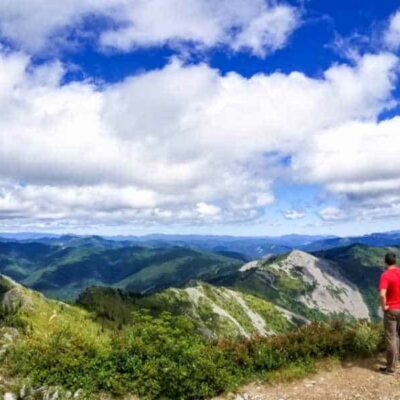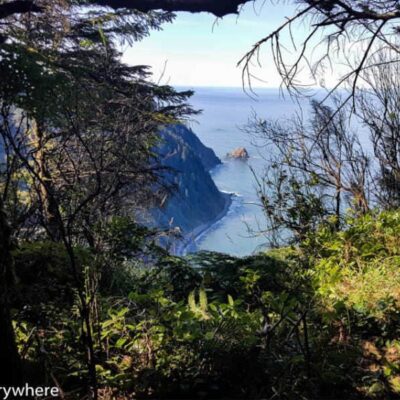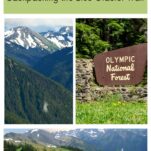My family and I spent four days backpacking the Blue Glacier Trail in the Olympic National Forest.
It was a challenging hike with breathtaking views and adventure. We created memories that we’ll cherish forever.

What is the Blue Glacier Trail?
The Blue Glacier Trail is in the Olympic National Park’s Hoh Rainforest and takes you through one of the most majestic landscapes in Washington State.
The trail passes through lush rainforest and towering old-growth forest. Every step takes you deeper into another world.
The path itself is full of adventure as it winds its way through a variety of terrains and ecosystems.
The trail ends with a stunning view of the Blue Glacier and Mount Olympus.
No matter how many backpacking trips you’ve tackled, Blue Glacier Trail offers an unforgettable experience.

Why hike the Blue Glacier Trail?
Hiking the Blue Glacier Trail is a unique opportunity to immerse yourself in the diverse ecosystems of Washington State’s Olympic National Park.
The trip through the Hoh Rainforest is pure beauty, with the trail winding through dense, old-growth forests that feel untouched by humans or time.
The path alongside the Hoh River gives you a soothing backdrop of rushing water, adding to the trail’s charm.
The weather in the rainforest can be unpredictable, and yes, it’s common to experience the quintessential drizzly rain of the Pacific Northwest.
It is a rainforest, after all!
This is part of the rainforest experience; the vibrant greens of the moss and foliage are even brighter when they’re wet.
Reaching the Blue Glacier is the highlight for many hikers. On a clear day, the view of the glacier against Mount Olympus is nothing short of spectacular.
We were blessed to see this massive sheet of ice on a clear blue sky day. We even heard the ice cracking and creaking as we ate snacks overlooking the glacier field.

Preparing for your hike
Best times of year to hike Blue Glacier
The ideal time to hike the Blue Glacier Trail is during the late spring through early fall, specifically from May to September.
During these months, the weather is more stable, and the trail conditions are generally drier and more accessible.
Summer offers the warmest temperatures and the best chance for clear skies, especially important for those looking to catch a glimpse of the Blue Glacier and Mount Olympus in their full glory.
Special considerations for the Hoh Rainforest climate
The Hoh Rainforest is renowned for its rain, contributing to its lush, green landscapes.
Here are a few considerations to keep in mind (more on gear later in the post).
- Rain Gear: Regardless of the season, packing waterproof clothing and gear is essential. A good quality rain jacket, waterproof pants, and a backpack cover can make your hike much more comfortable.
- Trail Conditions: Be prepared for muddy sections along the trail, especially during and after rain. Waterproof hiking boots with good traction are recommended to navigate slippery paths.
- Layered Clothing: The temperature can vary significantly between the trailhead, the forest, and higher elevations near the glacier. Dressing in layers allows you to adjust to changing conditions.
- Humidity: The rainforest’s high humidity can make cool temperatures feel colder and warm temperatures feel hotter. Choose clothing that wicks moisture away from your body to stay comfortable.
Getting there
Inspired to go? Good! I thought you might be.

Driving to the Blue Glacier Trail is a scenic experience in itself.
Here’s how to reach the trailhead from Seattle or Portland.
From Seattle:
- Distance: Approximately 170 miles.
- Driving Time: Around 4 hours.
- Route: Take I-5 South to WA-8 West, transitioning to US-101 North. Follow US-101 North to Upper Hoh Road in Jefferson County. Continue on Upper Hoh Road to the Hoh Rain Forest Visitor Center, where the trailhead is located.
From Portland:
- Distance: Approximately 250 miles.
- Driving Time: Around 4.5 to 5 hours.
- Route: Take I-5 North towards Olympia, then switch to US-101 North. Follow the same directions as from Seattle once on US-101 North.
Parking and trailhead
Arrive at the Hoh Rain Forest Visitor Center early during peak season, as the lot can fill up quickly due to the area’s popularity.
The visitor center offers restrooms, potable water, and informative displays about the rainforest ecosystem, making it a great starting point to orient yourself before hitting the trail.
Remember to check the Olympic National Park’s official website for any alerts or updates regarding road conditions, trailhead access, and parking availability before your trip.
This ensures you have the most current information for a smooth start to your hiking adventure.
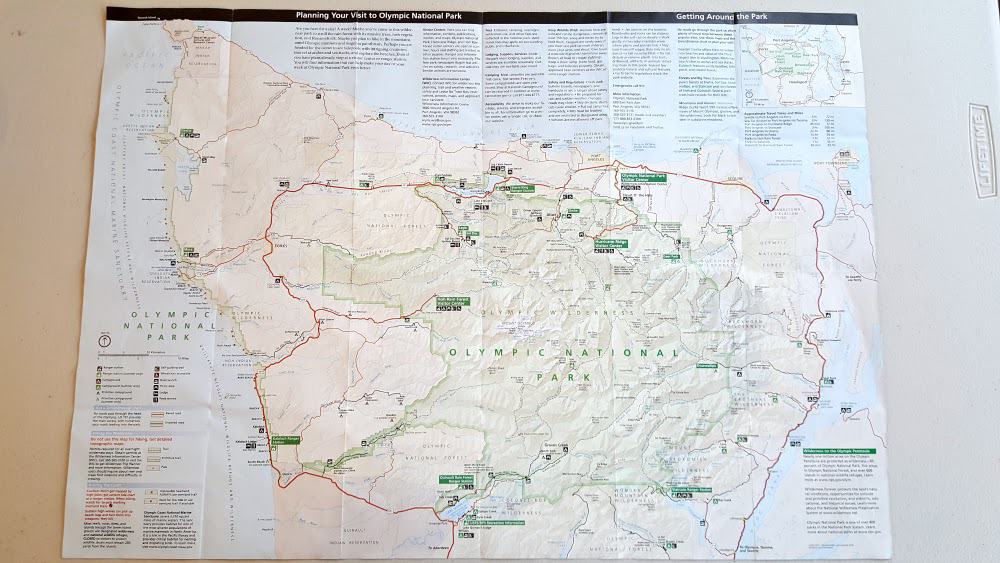
Park passes
Before setting off on your adventure through the Olympic National Park, you’ll need to get the right passes for access and parking, especially if you’re planning a multi-day trek.
National Forest Pass
For access to the Olympic National Forest and extended parking, you’ll need a National Forest Pass.
As of 2024, these were available for $30/year or $5/day at the park’s entrance booths. This pass is perfect for those planning a one-time visit.
America the Beautiful Pass
For those with a broader itinerary or planning multiple national park visits throughout the year, the America the Beautiful pass is an excellent investment.
Priced at $80, this pass grants entry to all National Forests across the USA, as well as National Park sites. The America the Beautiful Pass is one of the best bargains in the United States!
Getting permits to backpack in the Hoh Rainforest
Backpacking in the Hoh Rainforest requires your party to have a permit, ensuring your right to camp along the trail.
Where to purchase
Permit rules are always changing. Check out this Recreation.gov page for the most up-to-date information.
Permit cost
There’s a $6 reservation fee, plus a permit fee of $8 per person backcountry camping fee. Youth, under 15 are free.
Upon purchase, you’ll be given a tag with your information, which must be kept accessible at all times.
Rangers patrolling the trail will periodically check these permits to confirm your camping authorization.
Campsite reservations
It’s important to note that some campsites along the trail require reservations due to limited availability.
(more on campsites below)
The Blue Glacier Trail
The Blue Glacier Trail takes you deep into the Olympic National Park’s wilderness, offering a mix of serene forest walks, challenging sections of trail, and awe-inspiring natural beauty.
Here’s a detailed breakdown of the trail segments, highlighting key features and landmarks, along with tips for navigating the more challenging sections.
Start to Five Mile Island
- Distance:
The initial segment of the trail is relatively flat and winds through the lush Hoh Rainforest, covering approximately 5 miles to Five Mile Island. - Scenery:
Expect to be enveloped in the dense canopy of old-growth trees, with the constant murmur of the Hoh River accompanying your journey. The path is dotted with moss, ferns, and the occasional glimpse of wildlife. - Key Features:
Early on, you’ll cross several small streams via well-maintained bridges. Look out for the “Hall of Mosses” – an area so rich in greenery it feels like stepping into another world. - Tips:
This section is perfect for acclimatizing to the trail’s conditions. Keep a steady pace and save your energy for the more strenuous parts ahead.
Five Mile Island to Olympus Guard Station
- Distance:
From Five Mile Island, the trail begins to undulate more noticeably, leading up to the Olympus Guard Station, which is around nine miles from the start. - Scenery:
The forest opens up occasionally to reveal stunning river views and meadows, especially as you approach the guard station. - Key Features:
The Olympus Guard Station serves as a significant landmark and potential rest stop. Beyond this point, the trail starts to gain elevation, signaling the approach to more challenging terrain. - Tips:
Refill water bottles here and take a short break. The next segment includes more elevation gain and potentially challenging conditions.
Olympus Guard Station to Blue Glacier Viewpoint
- Distance:
The final stretch to the Blue Glacier viewpoint is the most challenging, with steep climbs and rugged terrain. It’s approximately 8 miles from the Olympus Guard Station to the glacier. - Scenery:
As you ascend, the dense forest gradually gives way to more open landscapes, with breathtaking views of the valley and Mount Olympus. - Key Features:
The highlight of this segment is undoubtedly the monkey ladder, located just over a mile before Glacier Meadows. This steep rope and wood rung ladder descends a shale embankment into a gully, offering an exhilarating challenge. The monkey ladder is one of our favorite things about this trail.
Dad, Drew, and Jordan were down in a jiffy; I am more cautious. - Tips:
Approach the monkey ladder with caution, especially if you’re carrying a heavy pack. Use the ropes to steady yourself and take it one step at a time. This section can be particularly tricky in wet conditions, so ensure you have good grip on your footwear.

Navigating challenging sections
Keep a steady pace throughout the hike, especially on the more challenging sections. It’s important to manage your energy efficiently.
Wear sturdy, waterproof hiking boots with good ankle support and grip to navigate slippery or steep sections safely.
Be prepared for sudden weather changes by carrying waterproof gear and layers. The weather can vary dramatically, especially as you gain elevation.
Camping on the trail
There are multiple camps along the Hoh River to Blue Glacier trail.
Here is a photo of the camps and the mileage between each camp.
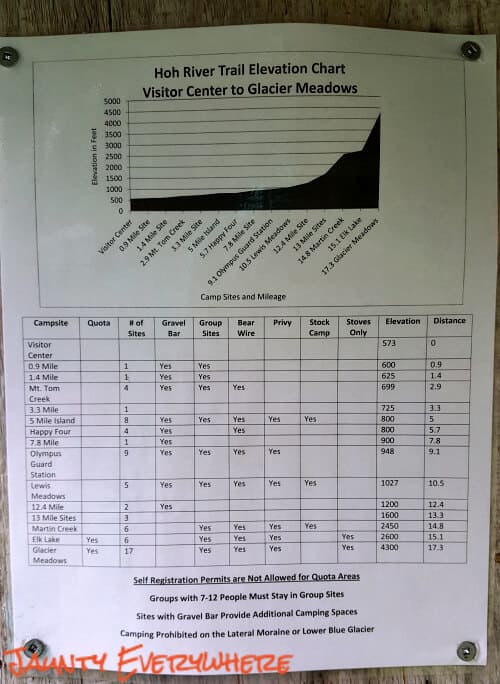
Recommended campsites and their features
- Five Mile Island:
An early option for those looking to set up camp relatively early into the hike. It offers beautiful views of the Hoh River and is an excellent spot for wildlife watching. - Olympus Guard Station:
Located about 9 miles from the trailhead, this site is near the ranger station and provides a good stopping point for those looking to break up the journey to Blue Glacier. It has access to water and is a good base for exploring nearby areas. - Lewis Meadow:
This campsite is further along the trail and offers stunning meadow views, making it a picturesque place to spend the night. It’s well-known for its serene setting and proximity to the river. - Elk Lake:
Elk Lake is situated closer to the glacier and provides a more secluded camping experience. It’s an ideal spot for those who want to be closer to the glacier and enjoy the tranquility of the higher elevation. - Glacier Meadows:
The last campsite before reaching the Blue Glacier, Glacier Meadows, is the base camp for those aiming to explore the glacier. It offers basic amenities and is the launching point for the final ascent to the glacier viewpoint.
Wildlife and safety
The Blue Glacier Trail, winding through the Olympic National Park, is home to a lot of wildlife.
This offers hikers the chance to witness the inhabitants of the Hoh Rainforest and surrounding areas in their natural habitat.
While these encounters can enhance the experience, it’s crucial to prioritize safety and respect for wildlife.
Common wildlife encounters
- Elk:
These majestic creatures are often seen in the meadows and along the riverbanks. While they may appear calm, keeping a safe distance is important, especially during the rutting season when males can be aggressive. - Black Bears:
Encounters with black bears can occur, especially in areas away from the trail where berries are abundant. Bears are generally shy but can become aggressive if surprised or if they feel threatened. - Mountain Goats:
While less common, mountain goats can be spotted in the higher, rocky areas of the trail. They are known for their agility and can be quite protective of their young. - Marmots and Other Small Mammals:
The trail is also home to marmots, squirrels, and other small mammals, which are often more visible and can be fun to watch during your hike.
How to safely observe wildlife
- Keep your distance:
Always maintain a safe distance from all wildlife. Use binoculars or a zoom lens to observe them closely without encroaching on their space. - Do not feed wildlife:
Feeding animals can alter their natural behaviors and make them dependent on human food. It can also make them persistent beggars, which can be somewhere between annoying to downright dangerous. You’re not doing yourself or the animals any favors. Always keep your food secure. - Stay on the trail:
Staying on designated trails minimizes your impact and reduces the likelihood of surprising wildlife. Making a decent amount of noise helps. - Store food properly:
Use bear-proof containers or storage options provided at campsites to securely store your food and scented items (this includes toiletries – toothpaste smells like a refreshing treat.)
Preparing your gear
When packing for a hike through the Hoh Rainforest, remember that you’re entering one of the most beautiful (and wet) environments in the world.
The right gear and clothing are not just about comfort; they’re about safety and enjoying the trail, rain or shine.
Essential gear and clothing
- Waterproof outerwear:
A high-quality, breathable rain jacket and rain pants are non-negotiable. They’ll keep you dry without trapping moisture and overheating you as you hike. - Layering:
Opt for moisture-wicking base layers that will keep sweat away from your skin. Add insulating layers, such as fleece or lightweight down jackets that can be easily adjusted as your body temperature changes. - Footwear:
Waterproof hiking boots with a sturdy grip are essential to navigating often slick and muddy trails. Pair them with wool or synthetic socks that can keep your feet warm even when wet. - Pack covers and dry bags:
Protect your backpack and its contents with a waterproof cover. Use dry bags or heavy-duty ziplock bags to keep critical items like sleeping gear, spare clothing, and electronics dry.
More gear tips for the rainforest
- Quick-dry camp outfit:
After a day of hiking in the rain, changing into dry, warm clothes can significantly improve your comfort and body temperature regulation. Pack a set of quick-dry leggings and a warm shirt, storing them in a waterproof bag to ensure they stay dry. - Sleeping gear:
Ensure your sleeping bag is suitable for the conditions. A sleeping bag rated for lower temperatures than you expect can be a lifesaver, especially when dampness in the air can make the nights feel colder. Consider a sleeping bag liner for an extra layer of warmth and a waterproof bivy sack to protect against moisture. - Staying dry at night:
Never sleep in wet clothes. Before bed, change into a dry set of clothes to avoid losing body heat overnight. Moisture-wicking thermal underwear is ideal for sleeping in, as it keeps you warm and dry throughout the night. - Pack a lightweight towel:
A quick-dry, microfiber towel can be invaluable for drying off before changing into your camp clothes or before bed. - Gloves and hat: Don’t forget warm, waterproof gloves and a hat to retain body heat, especially during cooler evenings and mornings.
Preparing your food and water
When it comes to backpacking, especially in environments as challenging and rewarding as the Blue Glacier Trail, how you plan your meals and water supply is crucial for maintaining energy, staying hydrated, and ensuring a smooth journey.
Backpacking meals
Keep them quick and easy.
The key to a satisfying and practical backpacking menu is simplicity and speed.
Conditions on the trail, such as weather and fatigue, can make elaborate meal prep impractical.
Here are some tips for planning your food:
- Ready-to-eat or quick-prep meals:
Opt for meals that require minimal preparation. Instant meals that just need boiling water are ideal for dinner, as they’re both comforting and easy to make. - Snackable lunches:
Since you’ll likely be on the move during lunch hours, pack foods that are easy to eat on the go. Foil pouches of salmon, tuna, or chicken are lightweight and can be paired with almond crackers for a nutritious and satisfying meal.
Supplement these with high-energy snack bars, nuts, and jerky to keep your energy up throughout the day. - Energy-dense snacks:
For quick energy boosts, pack a variety of snacks, such as trail mix, dried fruits, and chocolate. These can be easily accessed and consumed as you hike.
Bear cans
While bear cans were not mandatory in the Blue Glacier area at the time of writing (and that could change at any time), proper food storage is essential to avoid attracting wildlife to your campsite.
You’re still encouraged to have a bear canister. If you don’t hike often, there are canisters available for loan. A few caveats – the Wilderness Informations Center has to be open, the run out of canisters during busy months, and no, you can’t reserve them in advance.
In addition to bears, we’ve lost a meal or two to wily racoons. It’s never a bad idea to store your food high and secure.
- Bear wires:
Utilize bear wires provided at campsites to hang your food bags securely. This not only protects your food from bears but also from smaller critters that might be tempted by the scent of your meals or even non-food items like shoes. - Storage bags:
A drawstring bag or a dry bag is invaluable for keeping all your food items together. These bags make it easier to hang your food on bear wires and help organize your pack, making daily packing and unpacking more efficient.
Water
Water is the lifeline of any backpacking trip. Here are some considerations for managing your water needs:
- Water Sources:
Familiarize yourself with the location of water sources along the trail. Streams and rivers in the area are typically clean, but always be prepared to treat water. - Water Treatment:
Carry a reliable water filter or purification tablets. Even the clearest stream can contain microorganisms that could make you sick. - Carrying Capacity:
Have enough water bottles or a hydration bladder to carry a sufficient water supply between sources. It’s a good balance between carrying too much weight and staying adequately hydrated.
Hiking resources
For more information about the Hoh River trail, Olympic National Forest, and the Blue Glacier specifically, here are a few resources:
Hoh River Trail: National Park Service website
Olympic National Forest: National Forest info
The Blue Glacier Trail: Washington Trail Association website
Thanks for reading! I hope you find this helpful and get a chance to explore the beautiful Olympic National Forest.
Travel well!
And as an added bonus for making it to the end, here’s a slug…..



